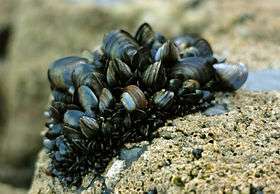Sessility (zoology)

In zoology, sessility is a characteristic of some aquatic animals, such that they are not able to move about. Sessile animals are usually permanently attached to a solid substrate of some kind, such as a part of a plant, a dead tree trunk, or a rock. For example, barnacles attach themselves to the hull of a ship, but corals lay down their own substrate.
Sessile animals typically have a motile phase in their development. Sponges have a motile larval stage, which becomes sessile at maturity. In contrast, many jellyfish develop as sessile polyps early in their life cycle. In the case of the cochineal, it is in the nymph stage (also called the crawler stage) that the cochineal disperses. The juveniles move to a feeding spot and produce long wax filaments. Later they move to the edge of the cactus pad where the wind catches the wax filaments and carries the cochineals to a new host.
Many sessile animals, including sponges, corals and hydra, are capable of asexual reproduction in situ by the process of budding.
Clumping
Clumping is a behavior in an animal, usually sessile, in which individuals of a particular species group close to one another for beneficial purposes, and can be seen in coral reefs and cochineal populations. This allows for faster reproduction and better protection from predators.
See also
References
|